A Post-Midnight Moon Multiplies Gemini Gems, and Pleasing Pre-dawn Planets!

The Open cluster Messier 35, also known as the Shoe-Buckle Cluster and NGC 2168 sits near the westerly foot of Castor in Gemini. The small open cluster NGC 2158 is to the lower right of it in this image from the Sloan Digital Sky Survey. The area of sky shown here measures about one finger’s width of the sky, left-to-right. Messier 35 is visible with unaided eyes from very dark sites, and in binoculars and backyard telescopes.
Hello, Spring Stargazers!
Here are your Astronomy Skylights for the week of March 20th, 2022 by Chris Vaughan. Feel free to pass this along to your friends and send me your comments, questions, and suggested topics. You can also follow me on Twitter as @astrogeoguy! Unless otherwise noted, all times are expressed in Eastern Time. To subscribe to these emails please click this MailChimp link.
If you’d like me to bring my Digital Starlab portable inflatable planetarium to your school or other daytime or evening event, or deliver a session online, contact me through AstroGeo.ca, and we’ll tour the Universe, or the Earth’s interior, together! My terrific new book with John A. Read entitled 110 Things to See With a Telescope is a guide to viewing the deep sky objects in the Messier List – for both beginners and seasoned astronomers. DM me to order a signed copy!
The late-rising moon will linger into morning this week as it wanes through third quarter. The resulting darker evenings will be ideal for end-of-winter deep sky object hunting, so we tour the sights in Gemini. Venus, Mars, and Saturn will group-up in the eastern pre-dawn sky, with Jupiter coming soon. Read on for your Skylights!
Happy March Equinox!
Today (Sunday, March 20 at 10:33 am EDT or 9:37 GMT), spring officially began in the Northern Hemisphere! I posted about it last week, here.
Evening Zodiacal Light
If you live in a location where the sky is free of light pollution, you might be able to spot the Zodiacal Light, which will appear during the two weeks that precede the new moon on Friday, April 1. After the evening twilight has disappeared, you’ll have about half an hour to check the western sky for a broad wedge of faint light extending upwards from the horizon and centered on the ecliptic below the bright Pleiades star cluster. That glow is the zodiacal light – sunlight scattered from countless small dust particles that populate the plane of our solar system. Recent studies point to Mars as a major contributor to the dust! Don’t confuse the zodiacal light with the winter Milky Way, which extends upwards from the southwestern evening horizon at this time of year.

The Moon
The moon will continue to brighten the night worldwide this week, but it won’t be rising until very late. Tonight (Sunday), the waning gibbous moon will rise after 10 pm local time, and shine brightly on the border between Virgo (the Maiden) and Libra (the Scales). That late rising will allow the moon to linger into the early morning daytime sky. As this week wears on, it will shine longer in daylight, like an echo of the night.
It is perfectly safe (and fun!) to view the moon through binoculars and telescopes in daytime – as long as you take care to keep all optics aimed away from the sun. (Parental supervision is a must.) Try observing the moon in daytime (with or without optical aids) while wearing a pair of 3D glasses from the cinema. They contain polarized lenses that will enhance the daytime moon by darkening the sky around it. Rotate your head until you find the angle that works best.
On Monday night, the moon will rise in central Libra around midnight. Between midnight on Tuesday night and dawn on Wednesday, morning, the waning gibbous moon will be dancing among the claw stars of Scorpius (the Scorpion) and shining near its bright, reddish star Antares, “the Rival of Mars”. Look for them positioned low in the southeastern sky during the wee hours of the night, and then partway up the southern sky before dawn. The moon will be positioned several finger widths above (or a few degrees to the celestial north of) Antares the entire time.

On Thursday morning, the moon will shine between the summertime constellations of Scorpius (the Scorpion), teapot-shaped Sagittarius (the Archer), and Ophiuchus (the Serpent-Bearer). The moon will officially reach its third quarter phase at 1:37 am EST or 05:37 Greenwich Mean Time on Friday, March 25. At third (or last) quarter the moon is half-illuminated, on its western, sunward side. It will rise around midnight, and then remain visible until it sets in the western daytime sky in late morning. The week of dark, moonless evening skies that follow this phase are ideal for observing deep sky targets.
On the coming weekend, the moon’s waning crescent form will be visible low in the southeastern sky for an hour or two before sunrise, sharing the sky with several bright planets. It’ll visit them next week!
The Planets
This week, three bright planets will be shining in the southeastern sky before sunrise. Very bright and white Venus will rise at about 5:20 am local time, only a few minutes before much fainter and redder Mars. The red planet will be positioned several finger widths to Venus’ right (or 5 degrees to the celestial southwest). The yellowish dot of Saturn, slightly brighter than Mars, will rise a short time after Venus.

The faster eastward motions of our two next-door neighbours Venus and Mars will carry them closer to Saturn as the week unwinds, eventually placing all three in the same field of view of binoculars. On Monday morning, Saturn will be located a palm’s width to Venus’ lower left. By next Sunday morning, Saturn will appear only two finger widths below (or 2.5 degrees to the celestial southeast of) Venus. The stars of Capricornus (the Sea-Goat) will surround them.
This morning (Sunday), Venus reached peak visibility at a maximum angle of 46.5° west of the sun – but it will be essentially as good for the next several mornings. In a telescope Venus will exhibit a half-illuminated, waxing crescent phase, which even good binoculars can reveal. Any size of telescope will show you Saturn’s full globe and its rings, while Mars will show a tiny, full disk. Those fainter planets will become hidden by the brightening sky before very long, so view them before 6:30 am local time. Bright Jupiter, which is climbing away from the morning sun, will soon join the other planets. Observers at southerly latitudes can look for the planet very low in the eastern sky just before sunrise this week – accompanied by Mercury from Monday to Wednesday. (Be sure to turn all optics away from the eastern horizon before the sun rises.)
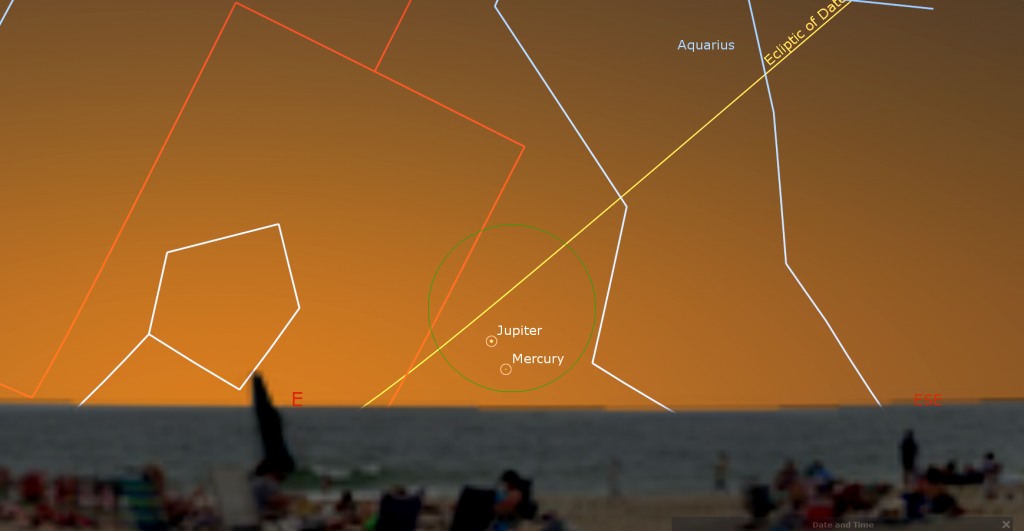
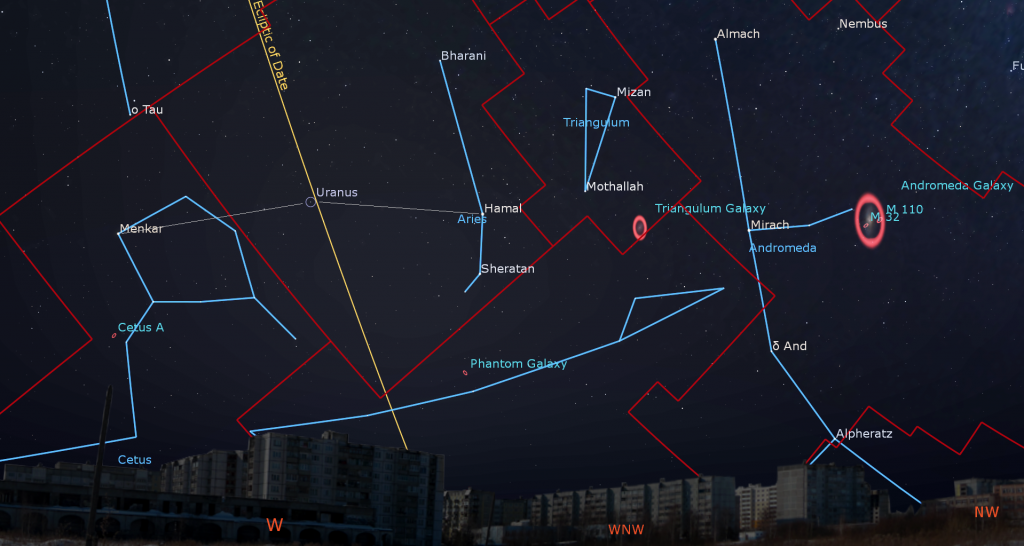
Viewing opportunities for Uranus, the only planet remaining in the evening sky, are nearly over for this year. Once the sky fully darkens, a little before 9 pm local time, use binoculars or a backyard telescope to look for the magnitude +5.8 planet shining in the lower third of the western sky. The planet’s small, blue-green dot will be positioned a generous fist’s width to the left of (or 11.5 degrees to the celestial southeast of) Hamal, which is the brightest star in Aries (the Ram). In fact, Uranus will be just above the midpoint of a line connecting Hamal with the bright star Menkar in Cetus (the Whale). After 9 pm Uranus will be getting a bit too low for decent views. This week Uranus will continue to travel slowly near a medium-bright, close-together double star named Struve 287 (or HIP 12349). Uranus will shine somewhat brighter than the pair.
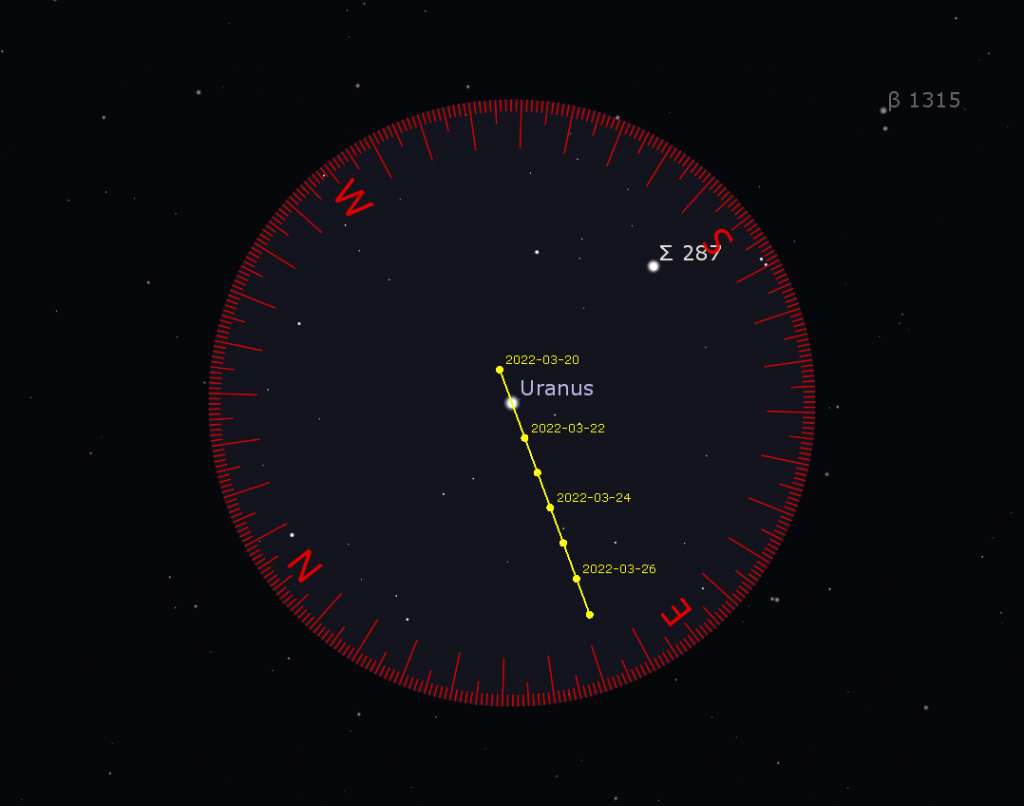
Gemini and Winter Treats for Dark Nights
The moonless evenings this week will be ideal for enjoying the best of the winter Milky Way – especially if you can escape the lights of the city. Even if you are limited to driveway stargazing, there is plenty to discover. I toured you through Orion (the hunter) here. Let’s highlight some gems to see in Gemini (The Twins) – with your unaided eyes, or in binoculars and telescopes.
In mid-evening during March, the zodiac constellation of Gemini (the Twins) is positioned high in the southern sky, to the upper left (celestial northeast) of Orion (the Hunter). Gemini is dominated by the bright stars Castor and Pollux, which mark the heads of the twins. At first glance, those two stars look alike – but they are somewhat different in brightness and colour. Castor is a white, magnitude 1.56 star of spectral class A1. A backyard telescope will resolve it into a pretty double star with a separation of 5.2 arc-seconds – but there are six stars located 51 light-years from our sun. Castor is always on the right-hand (western) side of the constellation when the twins are standing upright.

Pollux, the star marking the head of the more easterly (left-hand) twin shines at magnitude 1.17, making it slightly brighter than Castor. Pollux is a yellow giant star located 34 light-years from the sun. It is known to be orbited by a large, hot-Jupiter-type exoplanet proposed in 1993 and confirmed in 2006 by astronomer Artie P. Hatzes. Formally known as Pollux b, in 2014 the planet was assigned the name Thestias, after the maternal grandfather of Pollux in Greek mythology. The colour differences in the twin’s stars reflect their different photospheric temperatures. A star’s photosphere is its apparent surface, the radius where it becomes opaque to visible light. A-class Castor “burns” hotter than K-class Pollux.
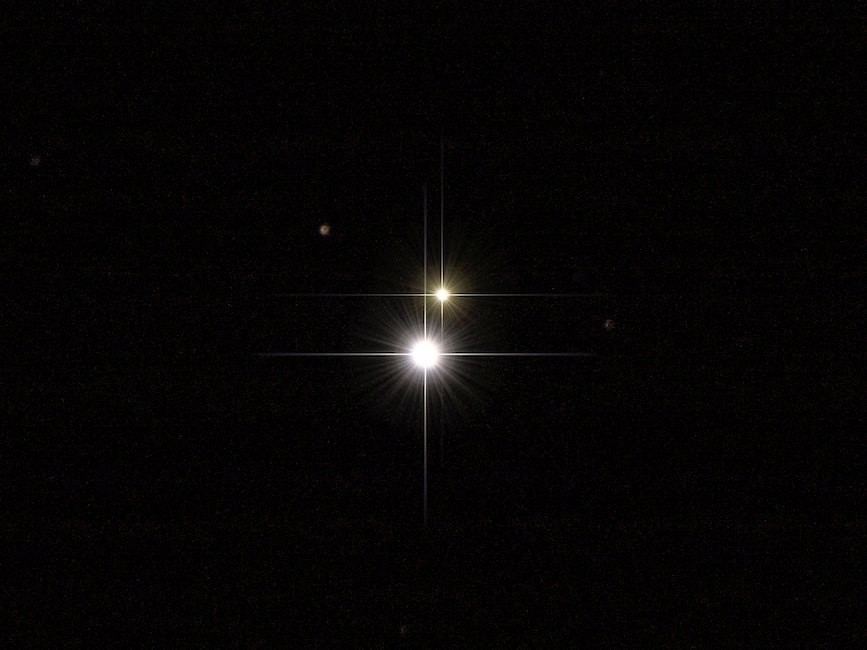
The very bright, orange star Betelgeuse in Orion (the Hunter) is located about three fist diameters to the lower right (or 33° to the celestial southwest) of Castor and Pollux. Two medium-bright stars sit about midway between Castor and Pollux and Betelgeuse. On the east, the magnitude 3.5 star named Wasat, from the Arabic word for “middle”, marks Pollux’ waist. It’s also designated Delta Geminorum (δ Gem). The yellowish, magnitude 3.1 star named Mebsuta or Epsilon Geminorum (ε Gem) defines Castor’s waist. Mebsuta used to be part of another Arabic star pattern. Its traditional names Mebsuta, Melboula, and Melucta all come from an Arabic phrase referring to the outstretched paw of a lion. The yellowish, medium-bright star below and between Wasat and Mebsuta, named Mekbuda or Zeta Geminorum (ζ Gem), was another part of that lion’s folded paw. Mekbuda marks Pollux’ western knee; his eastern knee is a slightly brighter, whiter star named Lambda Geminorum (λ Gem).
Have a look for the crooked line of five stars that forms the hands and arms of the twins. Running from left to right (or celestial southeast to northwest) below Castor and Pollux, they are Kappa, Upsilon, Iota, Tau, and Theta Geminorum. Spanning about 1.4 fist diameters, they are almost bright enough to see from the suburbs on moonless nights.
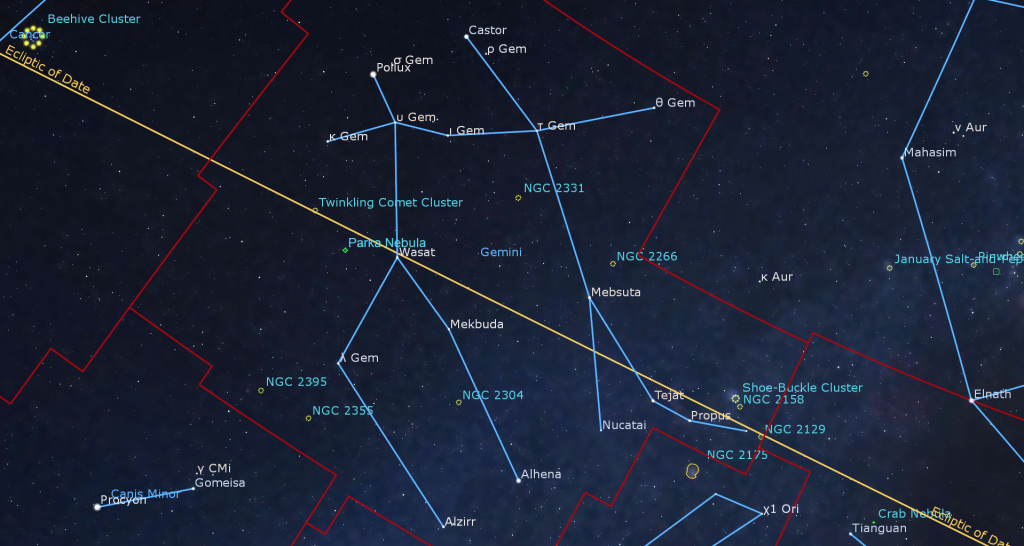
A row of widely-spaced stars occupying the sky below (south of) Wasat and Mebsuta represent the feet of Gemini. At lower left (southeast) is warm white Alzirr or Xi Geminorum (ξ Gem) from the Arabic al-zirr “the button”. Alzirr is accompanied by several nearby, fainter stars. Several finger widths to its upper right (celestial west) is the white star Alhena or Gamma Geminorum (γ Gem). Alhena is derived from the Arabic phrase Al Han’ah, “the brand (on the neck of the camel)”. Its alternate name Almeisan is from Al Maisan, “the shining one”. Pollux’ eastern and western foot stars are 58 and 110 light-years from our sun, respectively.
Several finger widths to Alhena’s upper right sits dimmer Nu Geminorum (v Gem), an easy-to-split double star located 544 light-years away. The main star in that pair is a blue giant. Castor’s westerly foot is made from two reddish, M-class stars named Tejat Posterior and Tejat Prior – plus a fainter “toe” star to their right (west) designated 1 Geminorum. Tejat Prior is often called or Propus (η Gem), from the Greek term for “forward foot”, since it precedes the others across the sky. The gentle arc formed by the stars of both twins’ feet was also called “the Camel’s Hump” by ancient Arab astronomers.
The twins of Gemini are both cooling their toes in the Milky Way, so the southwestern realm of the constellation includes many deep sky gems. The sky to the upper right (northwest) of Propus hosts Messier 35, a beautiful, bright open star cluster composed of more than 100 brighter stars. Some star maps label it as the Shoe-Buckle Cluster. You can see Messier 35 with your unaided eyes if the sky is dark, and in binoculars or small telescopes. A fainter and more distant cluster designated NGC 2158 sits only a pinky finger’s width below (southwest of) Messier 35. A faint, but large nebula called the Jellyfish Nebula (or IC 443) is located between Tejat Posterior and Propus.
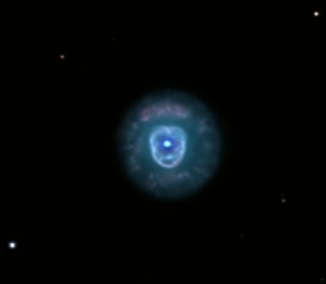
The Parka Nebula (also designated NGC 2392) is a spectacular planetary nebula visible in backyard telescopes. But use high magnification because it’s tiny – like a distant planet! This corpse of a former sun-sized star actually resembles a face surrounded by a fur-lined parka. The magnitude 9.1 object sits a little more than 2 finger widths to the left (southeast) of Wasat. Another lovely open star cluster designated NGC 2420, and sometimes called the Twinkling Comet Cluster, is located two finger widths to the left (or 2.25° to the celestial northeast) of the Parka. The easiest way to find it is to look 4 finger widths to the lower left (celestial east) of Wasat.
A brighter nebula called the Monkey Head (NGC 2174) is located two finger widths below (or 2° to the celestial south-southwest of) Propus, within the boundaries of Orion. And several more bright clusters and nebulas are located a few finger widths to the lower right of Alzirr, in northern Monoceros (the Unicorn).
Public Astro-Themed Events
Every Monday evening, York University’s Allan I. Carswell Observatory runs an online star party – broadcasting views from four telescopes/cameras, answering viewer questions, and taking requests! Details are here. They host in-person viewing on the first clear Wednesday night each month. Other Wednesdays they stream views online via the observatory YouTube channel. Details are here.
On Tuesday night, March 22 from 8 to 9 pm EDT, SkyNews Magazine editor Allendria Brunjes and Canadian astrophotographer Paul Owen will host Subs and Stars – Lesson 6 of a free, eight-part online series on astrophotography. This session will cover image processing of the data collected by RASC’s Robotic Telescope. Details are here, and the Zoom registration link is here.
On Friday evening, March 25 at 7:30 pm EDT, the RASC Mississauga Centre will stream their Speaker Night Meeting. The presenter will be Dr. JJ Kavelaars, a Principle Research Officer at the National Research Council of Canada’s Herzberg Astronomy and Astrophysics Research Centre. His topic will be Exploring a new world on the Edge of the Solar System: New Horizons and Arrokoth. Details and the Zoom link are here.
On Saturday, March 26 at 6 pm EDT, the Department of Astronomy & Astrophysics at the University of Toronto will stream their free AstroTour, celebrating Earth Hour 2022. Laura Sanders will talk about why we can trust climate models, Cameron So will share about how wild plants are affected by climate change, and Stephanie Gagliardi will talk about how climate change will impact your morning cup of coffee! Details and the YouTube and Zoom links are here.
Public sessions at the David Dunlap Observatory may not be running at the moment, but they are pleased to offer some virtual experiences instead in partnership with Richmond Hill. The modest fee supports RASC’s education and public outreach efforts at DDO. On Sunday afternoon, March 27 from 12:30 to 1 pm EDT, tune in for DDO Sunday Sungazing. Safely observe the sun with RASC, from the comfort of your home! During these family-friendly sessions, a DDO Astronomer will answer your questions about our closest star: the sun! Learn how the sun works and how it affects our home planet. Live-streamed views of the sun through small telescopes will be included, weather permitting. Only one registration per household is required. Deadline to register for this program is Wed., March 23, 2021 at 3 pm. Prior to the start of the program, registrants will be emailed the virtual program links. More information is here and the registration link is here.
My free, family-friendly Insider’s Guide to the Galaxy webcasts with Samantha Jewett of RASC National returns on Tuesday, March 29 at 3:30 pm EDT, when we’ll talk about how to see all 110 objects in Charles Messier’s list in a single night! And – we’ll continue with our Messier Objects observing certificate program. You can find more details and the schedule of future sessions here.
Don’t forget to take advantage of the astronomy-themed YouTube videos posted by RASC Toronto Centre and RASC Canada.
Keep looking up, and enjoy the sky when you do. I love questions and requests. Send me some!